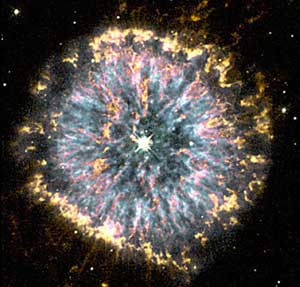In 1931, an American engineer detected a mysterious radio wave. This wave appeared daily, with a cycle that matched the time taken for the Earth to complete one rotation relative to the celestial sphere. Further research confirmed that this was an electromagnetic wave coming from the center of the Milky Way. Moreover, many celestial bodies in the universe act like powerful radio transmitters, which we can detect using electronic telescopes on Earth. This is the source of the radio waves.
 |
Radiation from a celestial body in the universe |
Modern electronic telescopes reveal that cosmic radio signals are emissions from celestial bodies. These cosmic rays carry immense energy, with the speed of the particles approaching that of light. When cosmic rays penetrate the outer atmosphere of the Earth, they collide with gas molecules, causing other particles to be ejected. By the time they reach the ground, we can record and process these signals with computers, ultimately producing a pattern resembling a tree ring on wood, indicating the strength of the wave source. A prime example is the wave pattern A from the Cygnus constellation, which looks like two “pupils” of an eye. Remarkably, these two rings are not positioned at the same location within the star system but are symmetrically located on either side of the star system, separated by 300,000 light-years. Astronomers have used optical telescopes to search for the region of the sky containing these two “pupils,” but have found nothing. Clearly, many wave sources can be traced to a corresponding celestial body, yet the situation with wave A from the Cygnus constellation is quite different.
Most extragalactic star systems emit radio waves. Currently, thousands of cosmic radio wave sources have been identified. These sources function like radio stations continuously transmitting new cosmic signals to us.
The discovery of cosmic radio wave sources represents a significant advancement in modern electronic astronomy, allowing us to gain deeper insights into the universe. These are referred to as “windows of radio waves.”
Four major astronomical discoveries in the 1960s—star clusters, pulsars, molecular stars, and cosmic microwave background radiation—were all made utilizing electronic astronomical methods. These discoveries have made important contributions to astronomy and physics during this era.

Wave patterns of the Cygnus constellation (Image: csep10.phys)




















































